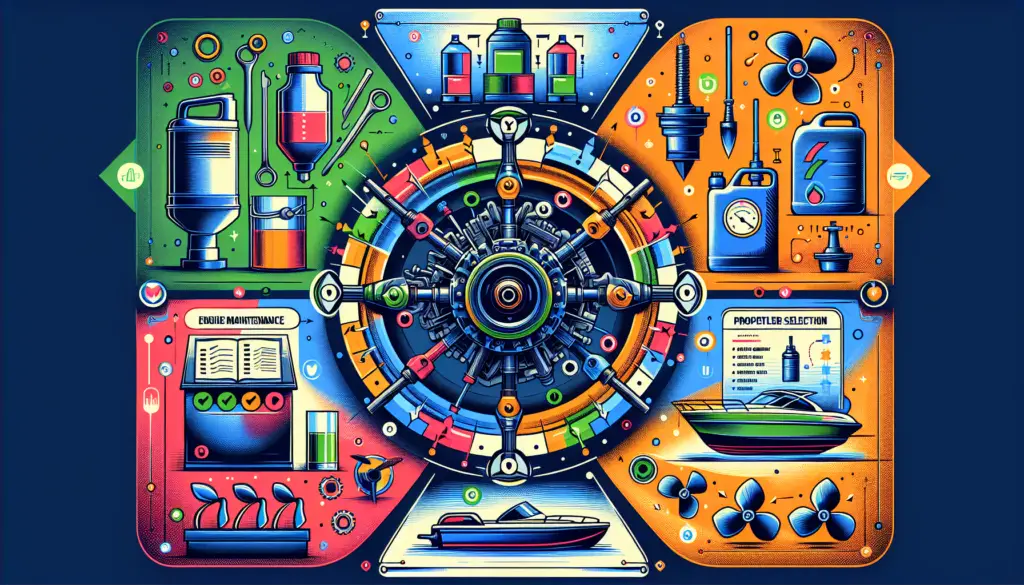If you’re an avid boat enthusiast or simply looking to increase the power and performance of your boat engine, then this article is for you. We’ll explore the key considerations for supercharging your boat engine, outlining the benefits, potential drawbacks, and important factors to keep in mind. Whether you’re seeking a thrilling experience on the water or hoping to gain a competitive edge in racing, understanding how to supercharge your boat engine is essential. From selecting the right type of supercharger to ensuring proper maintenance, we’ll guide you through the process step by step. So buckle up and let’s dive into the world of supercharged boat engines!

1. Engine Type
When it comes to supercharging your boat engine, the first consideration is the type of engine you have. There are a few different options to choose from, each with its own set of advantages and disadvantages.
1.1 Two-Stroke Engines
Two-stroke engines are a popular choice for smaller boats. They are lightweight, simple in design, and typically less expensive than four-stroke engines. However, they tend to be less fuel-efficient and produce more smoke and pollution than their four-stroke counterparts.
1.2 Four-Stroke Engines
Four-stroke engines have become the industry standard for many types of boats. They offer improved fuel efficiency, quieter operation, and lower emissions compared to two-stroke engines. While they may be slightly heavier and more expensive upfront, their long-term benefits often outweigh these drawbacks.
1.3 Inboard Engines
Inboard engines are typically found in larger boats and are mounted inside the hull. They are known for their power and reliability, making them a popular choice among serious boaters. Supercharging an inboard engine can provide significant performance gains, but it is important to ensure compatibility and make any necessary engine reinforcements.
1.4 Outboard Engines
Outboard engines are mounted on the rear of the boat and are more commonly used in smaller vessels. They offer versatility, easy maintenance, and the ability to tilt out of the water when not in use. Supercharging an outboard engine can deliver impressive speed and acceleration, but it is essential to consider the engine’s design limitations and cooling requirements.
1.5 Diesel Engines
Diesel engines are known for their torque and fuel efficiency, making them popular choices for larger boats and commercial applications. Supercharging a diesel engine can further enhance its performance, but it is crucial to ensure compatibility with the engine’s components and fuel requirements.
2. Power Output
When considering supercharging your boat engine, it is important to understand the effects on power output. Here are some key factors to consider:
2.1 Horsepower
Horsepower is a measure of the engine’s ability to do work over time. Supercharging your boat engine can significantly increase horsepower, resulting in improved speed and acceleration on the water. However, it is important to balance the increased power with other considerations such as fuel consumption and engine reliability.
2.2 Torque
Torque is the rotational force produced by the engine and is crucial for accelerating heavy loads or towing. Supercharging your boat engine can provide a substantial increase in torque, allowing for better performance in challenging water conditions. Just like with horsepower, it is important to ensure the engine and supporting components can handle the additional torque.
2.3 RPM Range
The RPM range refers to the range of engine speeds at which it operates effectively. Supercharging can expand the RPM range, providing more power across a broader spectrum. This can result in faster acceleration and improved performance at higher speeds. However, it is important to consider the engine’s durability and any limitations imposed by the manufacturer.

3. Supercharger Types
Superchargers come in different types, each with its own characteristics and performance attributes. Understanding these types can help you choose the right one for your boat engine.
3.1 Positive Displacement Superchargers
Positive displacement superchargers deliver a constant boost throughout the entire RPM range. They are known for their excellent low-end torque and immediate throttle response. These superchargers tend to be more compact and provide consistent power gains. However, they can be more challenging to install and may require additional engine modifications.
3.2 Centrifugal Superchargers
Centrifugal superchargers operate by compressing the air through a rotating impeller. They are known for their efficiency and ability to deliver higher boost pressures at higher RPMs. These superchargers are often compact and can be installed without significant modifications. However, they may not provide as much low-end torque as positive displacement superchargers.
3.3 Twin-Screw Superchargers
Twin-screw superchargers use a pair of meshing screws to compress the air, delivering consistent power throughout the RPM range. They are known for their high efficiency, low heat generation, and ability to provide a significant boost in torque. These superchargers are often more expensive but offer excellent performance gains and lower maintenance requirements.
4. Compatibility
Before diving into supercharging your boat engine, it is crucial to ensure compatibility with your existing setup. Consider the following factors:
4.1 Engine Compatibility
Not all engines are suitable for supercharging, so it is essential to check with the manufacturer or a qualified mechanic to determine if your engine can handle the additional stress. Engine components such as pistons, connecting rods, and valves may need reinforcement to handle the increased power and heat generated by the supercharger.
4.2 Fuel Requirements
Supercharged engines typically require higher octane fuel to prevent detonation or “knocking.” It is important to consult the supercharger manufacturer or a qualified tuner to determine the appropriate fuel requirements for your specific setup. Failure to use the correct fuel can result in engine damage and decreased performance.
4.3 Cooling System
Supercharging your boat engine can generate additional heat, so it is important to ensure your cooling system can handle this increased load. Upgrading the radiator, adding an intercooler to cool the compressed air before it enters the engine, and improving water flow through the engine can all help manage the heat generated by the supercharger.

5. Cost and Budget
Supercharging your boat engine can come with a significant investment, so it’s important to consider the cost implications before diving in. Here are some key cost considerations:
5.1 Supercharger Kit Cost
The cost of a supercharger kit can vary depending on the brand, type, and complexity of the setup. Entry-level kits can start around a few thousand dollars, while high-end setups can cost tens of thousands. It is essential to research and compare different options to find one that fits your budget and performance goals.
5.2 Installation Cost
Installing a supercharger can be a complex process, and unless you have the necessary skills and experience, it is recommended to have a professional handle the installation. The cost of installation can vary depending on the complexity of the setup, your location, and the shop’s rates. It is important to factor in this cost when budgeting for your supercharger upgrade.
5.3 Maintenance Costs
Supercharged engines may require more frequent maintenance intervals, and it is important to factor in the additional costs. Regular maintenance tasks such as oil changes, spark plug replacements, and supercharger belt inspections may need to be performed more frequently. Additionally, any necessary repairs or replacements can add to the ongoing cost of owning a supercharged boat engine.
6. Performance Gains
Supercharging your boat engine offers several performance benefits that can enhance your boating experience. Here are some key gains to expect:
6.1 Increased Horsepower
With the addition of a supercharger, your boat engine can experience a significant increase in horsepower. This translates to improved speed and acceleration on the water, allowing you to reach your destination faster and enjoy a more thrilling boating experience.
6.2 Improved Torque
Supercharging your engine can provide a notable boost in torque, giving you the power needed to tackle challenging water conditions, tow heavy loads, or overcome resistance. Improved torque allows for better control and maneuverability, enhancing your overall boating performance.
6.3 Faster Acceleration
By increasing power output, a supercharger enables faster acceleration, allowing you to quickly reach your desired speed. Whether you’re pulling a water skier or simply cruising along, faster acceleration can enhance the enjoyment of your time on the water.
6.4 Enhanced Top Speed
Supercharging your boat engine can also result in an improved top speed, allowing you to push the limits and experience the thrill of higher velocities. The added power from the supercharger can propel your boat to new speeds, giving you a competitive edge or simply a more exhilarating ride.

7. Fuel Efficiency
One concern often associated with supercharging is the impact on fuel efficiency. While it is true that additional power can lead to increased fuel consumption, there are ways to mitigate this effect. Consider the following:
7.1 Impact on Fuel Consumption
Supercharging your boat engine will likely result in higher fuel consumption, as the increased power requires more fuel to sustain. However, advancements in supercharger technology and modern engine management systems can help optimize fuel efficiency. Maintaining proper engine tuning, avoiding excessive throttle usage, and using fuel-saving techniques can help mitigate the impact on fuel consumption.
7.2 Fuel Mapping and Tuning
Proper fuel mapping and tuning are crucial to optimizing your supercharged engine’s fuel efficiency. Working with a knowledgeable tuner or professional can help ensure that your engine is running at its optimal fuel-to-air ratio, reducing unnecessary fuel consumption and maximizing performance.
8. Reliability and Durability
Supercharging your boat engine can provide a significant performance boost, but it is crucial to consider the impact on reliability and durability. Here are some key factors to keep in mind:
8.1 Supercharger Material
The material of the supercharger itself plays a role in its durability and longevity. Different superchargers are constructed using various materials, such as aluminum or durable polymers. It is important to choose a supercharger made from high-quality materials to ensure its reliability and longevity.
8.2 Proper Engine Reinforcements
Supercharging your boat engine can put additional stress on various components, such as pistons, connecting rods, and valves. It is crucial to reinforce these engine parts to handle the increased power and heat generated by the supercharger. Failing to do so can result in engine damage or failure.
8.3 Regular Maintenance
Maintaining your supercharged boat engine is essential for its long-term reliability. Regular oil changes, fluid checks, and inspections can help identify any potential issues before they become major problems. Additionally, following the manufacturer’s recommended maintenance schedule and consulting with a qualified mechanic can ensure your engine stays in optimal condition.

9. Installation Process
Installing a supercharger on your boat engine requires careful consideration and proper execution. Here are some key factors to understand:
9.1 DIY or Professional Installation
While some experienced boaters may choose to install the supercharger themselves, it is generally recommended to have a professional handle the installation. A professional installer has the expertise, tools, and knowledge necessary to ensure a proper and safe installation. They can also provide guidance on engine reinforcements and other necessary modifications.
9.2 Engine Modifications
Depending on your boat engine and the type of supercharger you choose, you may need to make certain modifications to accommodate the supercharger. This can include reinforcing engine components, upgrading the cooling system, or installing an intercooler. Working with a knowledgeable mechanic or installer can help ensure that all necessary modifications are made.
9.3 Intercooler Setup
An intercooler is typically recommended for supercharged engines to cool the compressed air before it enters the engine. This helps lower intake temperatures and increase overall performance. It is important to ensure that the intercooler is properly installed and sized for your engine setup to maximize its effectiveness.
10. Safety Considerations
Supercharging your boat engine can unleash significant power, but it is crucial to prioritize safety. Here are some key safety considerations:
10.1 Heat Management
Superchargers generate heat during operation, and it is crucial to have proper heat management systems in place to prevent overheating and potential engine damage. This can include upgrading the cooling system, installing heat shields, and ensuring sufficient ventilation in the engine compartment.
10.2 Pressure Regulation
Proper pressure regulation is vital to prevent excessive stress on engine components and maintain reliability. It is important to ensure that the supercharger and its associated components, such as the wastegate or blow-off valve, are properly sized and calibrated. Working with a professional installer or tuner can help ensure that pressure regulation is optimized for your specific setup.
10.3 Fuel System Upgrades
Supercharging your boat engine can increase fuel demand, and it is important to ensure that your fuel system can handle the additional flow. Upgrading fuel injectors, fuel pumps, and fuel lines may be necessary to maintain adequate fuel delivery. Failing to address fuel system requirements can result in lean conditions, which can cause engine damage or even failure.
In conclusion, supercharging your boat engine can offer substantial performance gains, improved acceleration, and enhanced top speed. However, it is important to consider factors such as engine compatibility, cost and budget, fuel efficiency, reliability, and safety before undertaking a supercharger upgrade. By carefully weighing these considerations and working with professionals, you can enjoy the benefits of a supercharged boat engine while ensuring optimal performance and durability.

